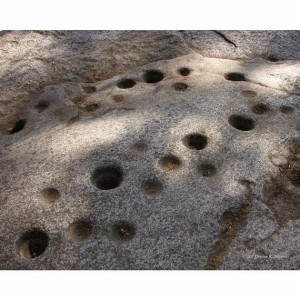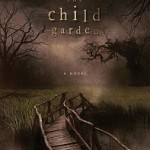 Don’t get me wrong, I’m very happy in Northern California but sometimes I miss the . . . old stuff that surrounded me in Scotland. The mediaeval streets, the fortified castles, the Roman walls, and of course the really old stuff: the standing stones.
Don’t get me wrong, I’m very happy in Northern California but sometimes I miss the . . . old stuff that surrounded me in Scotland. The mediaeval streets, the fortified castles, the Roman walls, and of course the really old stuff: the standing stones.
I’ve got an ambivalent attitude to standing stones, actually. I sort of love them but they also sort of terrify me. One of the scariest things I’ve ever read in a novel is when Gideon in The Testament of Gideon Mack (James Robertson) goes out for a run in the woods and sees an ancient, mossy, lichened standing stone . . . that wasn’t there the day before. Brrrr!
 So it’s no surprise that the standing stone that rolled onto the pages of my latest book, The Child Garden, is somewhat creepy. It’s a rocking stone: a stone that sits so loosely in a cup in the earth that you can make it move by touching it. They’re very rare, because usually they’ve been pushed too hard and have tumbled out of their cup to rock no more. Where they exist and still rock, inevitably folklore has risen up around them – good luck, bad luck and as night follows day, tales of the devil.
So it’s no surprise that the standing stone that rolled onto the pages of my latest book, The Child Garden, is somewhat creepy. It’s a rocking stone: a stone that sits so loosely in a cup in the earth that you can make it move by touching it. They’re very rare, because usually they’ve been pushed too hard and have tumbled out of their cup to rock no more. Where they exist and still rock, inevitably folklore has risen up around them – good luck, bad luck and as night follows day, tales of the devil.
I don’t want to say any more than that but I will say that if I were a native, rather than a transplant, in California – where historic buildings are sometimes not even two hundred years old – this story would probably never have occurred to me.
The first year I moved here, I didn’t actually know what it was I was missing. I revelled in the endless clear days of sunshine, the endless clear nights where you could watch the moon wax and wane, the endless white sand of Carmel Beach . . . and yet, and yet.
It wasn’t until I went to the pictures to watch The King’s Speech that it hit me. Helena Bonham Carter walked across that creaky floor in that scruffy basement and I thought: “Ah! Old stuff!”
Then about a week later, as if the gods were smiling on me, I found some. I visited the Indian Grinding Rock State Park, at a place called Chaw’se where the Miwok people used to gather in the autumn to grind acorns into flour, where they built a hun’ge (or roundhouse) for ceremonies, and where they still – in a new roundhouse – have Big Time several days a year.
Finally! I thought. Proper old stuff. Really old stuff.
 The holes and petroglyphs in that rock are thousands of years old. I visited Chaw’se quite a few times as I adjusted to California life. One time I’m not proud of I stood weeping at the rock, berating the Miwok people for not leaving anything behind them. For actually making a point of burning a person’s possession as part of their funeral. “I know you were here!” I said. “Would it have killed you to put up a stone building or two? I’m lonely.” As if the Miwok didn’t have better things to do and then, so horrifically, worse troubles.
The holes and petroglyphs in that rock are thousands of years old. I visited Chaw’se quite a few times as I adjusted to California life. One time I’m not proud of I stood weeping at the rock, berating the Miwok people for not leaving anything behind them. For actually making a point of burning a person’s possession as part of their funeral. “I know you were here!” I said. “Would it have killed you to put up a stone building or two? I’m lonely.” As if the Miwok didn’t have better things to do and then, so horrifically, worse troubles.
The happiest visit happened the day before Big Time. I wouldn’t have been allowed in on the day itself – it’s always rude to crash a party – but as people gathered and set up they were very welcoming. They let me go into the hun’ge, teaching me how to walk in the footsteps already made in the freshly spread dust, how to back out again and give honour at the door before walking away.
It all felt very familiar. Doing something ancient, because your people always have, taking it seriously with a light heart, knowing it matters but it’s not solemn – that sums up how it felt to live in Scotland in a lot of ways. From first footing at Hogmanay, to the dew of the Beltane, to the high jinks of the Samhain, the year was made up of a lot of days quite like Big Time.
But even the Miwok people would probably raise their eyebrows at the Burry Man!

~~~~~~~~~~~~~~~~~~~~~~~~~
Catriona McPherson writes the Agatha and Macavity winning Dandy Gilver detective series, set in her native Scotland in the 1920s. The latest, A DEADLY MEASURE OF BRIMSTONE, won a third consecutive Left Coast Crime award this year. In 2013 she started a strand of darker (that’s not difficult) standalones. The first, AS SHE LEFT IT, won an Anthony award and THE DAY SHE DIED was shortlisted for an Edgar. THE CHILD GARDEN comes out on the 8th of September.
 Catriona immigrated to America in 2010, and lives in northern California with a black cat and a scientist. She is proud to be the 2015 president of Sisters in Crime. You can learn more about Catriona and her novels at her website. She can also be found on Facebook and Twitter.
Catriona immigrated to America in 2010, and lives in northern California with a black cat and a scientist. She is proud to be the 2015 president of Sisters in Crime. You can learn more about Catriona and her novels at her website. She can also be found on Facebook and Twitter.






CATRIONA, that is an extremely intriguing blog. I want to read your book very much! Glad to have you in our country!
Darla Bartos
I’m very happy to be here, Darla! Thank you
I had the same feeling going from east coast to west. ..everything is new there. But I’ve also wondered from time to time what it felt like to live in streets so old you couldn’t widen then and whether you smell the mustiness and dirt that accumulates over time. ..how it feels to live around things older than in the US. Thanks for sharing that perspective. And telling about living with old stones that speak to you. …
The lucky thing about the mustiness and dirt is . . . it rains practically all the time, so the streets are clean.
Thanks so much for the great article. Reminds me of my native land, Newfoundland, in eastern Canada. The first settlers there were the Vikings around 1100 AD, the first permanent settlement being in the 1580’s, and buildings in the capitol city of St. John;s from the 1700’s still standing. Your article was like a walk down memory lane, so to speak. I didn’t know about the rocking stones, but now I’ve got to go do some research and find if there are any nearby…. I feel a research trip coming on. Thanks, and thanks for all you do for SinC.
I’ve never been there, Donna. But The Shipping News made me put it on my wishlist.
What a lovely connection between past and present! Thanks, both, for sharing.
Thank you for sharing how you feel and felt about missing the “old stuff”.
Great post, Catriona. I love that line from Eddie Izzard: “I grew up in Europe, where the history comes from.” As someone originally from Miami (where history is anything older than 50 years), I love to go to Europe. I seem drawn to all that “old stuff.”
I love the description of the “rocking stones.” We like to think we have lots of old things in New England, but we know better. Our “old stuff” is just still new stuff for everyone else in the world.
Thank you for having me, Pat. It’s good to look back to those first days and see how much I’ve settled in now. (But I do get a yearly visit back to the old country to be feel the damp and smell the mould.)
Thank you for joining us here, Catriona. Everyone, you might want to check out the blog tour Catriona has lined up for the first part of September. You’ll find the details on her website: http://catrionamcpherson.com/news
Like others who’ve commented, I felt oddly at home in Europe, especially in the perched villages of southern France. Perhaps that’s where we realize we’re all throwbacks. And yes, I remember the mold on the inside walls of our rented apartment. That and the lavender we used to repel the mosquitoes that wandered in through the windows with no screens.
I love how eerie you made the standing stones sound, Catriona, the perfect compliment to a good mystery! It’s always fascinating to hear which snippets from real life make it into an author’s work. Every time I’ve traveled to Europe, I’ve come home astounded by the newness, the youth, of everything in Colorado. Thank you for sharing!
I didn’t know about the “rocking stones,” would love to see them.
I’m fascinated by the survival of the ancient things in the UK. I remember being told when I visited a church in England that it wasn’t really old–“only about 500 years.” When my English friend visited me in Canada, he spotted a plaque designating a building as a historic site, read it, and burst out laughing. The building had been erected in 1932, venerable for a west coast Canadian city, but the idea that it could be considered historic was hilarious to him.
Welcome to Northern Colorado via Pat’s place! Old stuff is great but when it’s attached to spiritual stuff, too– well, that’s why I wrote about Hopi. Someday we’ll have to get to Scotland because, well, Dave is Scotish, as are so many….
I’ve always found books, particularly mysteries, that deal with past relics fascinating. Sounds like just the kind of novel I enjoy reading! Best wishes.
This is such a lovely reflection, Catriona! You capture beautifully the awe/emotion to be felt in such historic places. Thank you for sharing (and the pic of the Burry Man is amazing too)!
It was great seeing you at WPA! When my son was in high school, his history teacher took the class to England. I was impressed that when he came home, it wasn’t all about how awesome the Hard Rock Cafe was, but how cool it was to walk through these really old buildings (and mentions of Shakespeare as well).
I think the need for “old stuff” is in our DNA. The first time I went to Italy and saw those ancient buildings, I thought, “I’m home.” As far as I know there isn’t a drop of Italian blood on either side of my family, so I reckoned it had to be some visceral longing for old stuff that made me feel at home.
They did leave behind their mortars.
We don’t have a lot of ancient stuff in this country. But just think, what we are doing now might one day be considered ancient.
I do know what you mean by old stuff though. I’ve been to places in Scotland where you can just feel it.